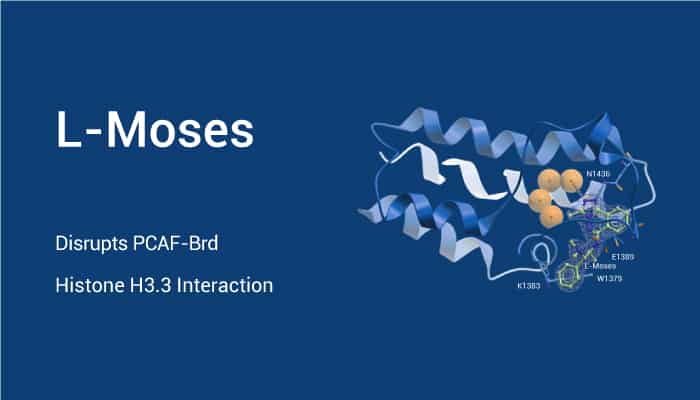Bromodomains proteins (Brds) bind to acetylated lysines (KAc) through the Brd acetyllysine-binding site. Misregulation of these proteins is linked to the onset and progression of multiple disease states. They include cancer, HIV infection, and neuroinflammation. The p300/CBP-associated factor, PCAF (KAT2B), is a multi-domain protein. It contains a single Brd, an N-terminal domain, and a histone acetyltransferase (HAT) domain. The development of a small molecule modulator of PCAF Brd would provide a useful tool for interrogating this potential therapeutic target and allow for dissociation of the roles of the Brd and enzymatic domains in disease. In this study, L-Moses is the first potent, selective, and cell-active PCAF Brd inhibitor. The Kd value is 126 nM. L -45 also shows a clean toxicity profile in primary PBMCs. It also disrupts interactions between PCAF Brd and H3.3 in HEK293 cells, indicating cellular target engagement.

L-Moses disrupts PCAF-Brd histone H3.3 interaction in cells. A co-crystal structure of L-Moses with the homologous Brd PfGCN5 from Plasmodium falciparum rationalizes the high selectivity for PCAF and GCN5 bromodomains. Moreover, L-Moses shows no observable cytotoxicity in peripheral blood mononuclear cells (PBMC), good cell-permeability, and metabolic stability in human and mouse liver microsomes. Thus, L-Moses has the potential for in vivo use.
In conclusion, L-Moses, the first nanomolar, selective, and cell-active chemical probe of the PCAF bromodomain. In addition, Iterative cycles of rational inhibitor design, in silico docking studies, and synthesis furnished L -45 after generation of a focused PCAF inhibitor library. Furthermore, L-Moses shows a clean toxicity profile in primary PBMCs. It also disrupts interactions between PCAF Brd and H3.3 in HEK293 cells, indicating cellular target engagement.
Reference:
Moustakim M, et al. Angew Chem Int Ed Engl. 2017 Jan 16;56(3):827-831.